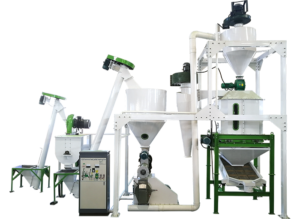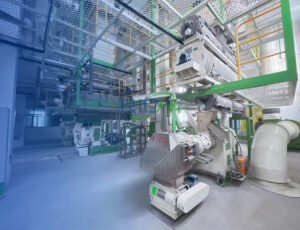
Investing in environmental protection measures is becoming increasingly important for feed mill operations, including those with a capacity of 10 tons per hour (t/h). While these investments are essential for regulatory compliance and sustainability, they can also impact the overall costs of running the feed mill. This article explores how environmental protection investments can affect the overall costs of a 10t/h feed mill and discusses strategies to balance these investments with operational efficiency.
Understanding Environmental Protection Investments
Environmental protection investments in a feed mill typically include:
- Dust Collection and Filtration Systems
- Wastewater Treatment Facilities
- Noise Reduction Measures
- Energy-Efficient Equipment
- Emission Control Systems
- Waste Management and Recycling Infrastructure
These investments aim to minimize the environmental impact of feed production, ensure compliance with regulations, and promote sustainable practices.
Related post: pet feed mill
Potential Cost Impacts
- Initial Capital Expenditure
Investing in environmental protection equipment requires significant upfront capital. For a 10t/h feed mill, these costs can include:
- Dust Collection Systems: $50,000 – $150,000
- Wastewater Treatment Facilities: $30,000 – $100,000
- Noise Reduction Measures: $20,000 – $50,000
- Energy-Efficient Equipment: $50,000 – $200,000
- Emission Control Systems: $40,000 – $100,000
- Waste Management Systems: $20,000 – $60,000
Total initial investment can range from $210,000 to $660,000, depending on the specific requirements and scale of the environmental measures implemented.
- Operational Costs
Environmental protection measures can also impact ongoing operational costs:
- Energy Consumption: Some environmental systems, such as dust collectors and wastewater treatment plants, require additional energy to operate, potentially increasing energy costs.
- Maintenance: Regular maintenance of environmental protection equipment is necessary to ensure optimal performance, adding to the overall maintenance budget.
- Labor: Additional labor may be required to operate and maintain environmental systems, increasing labor costs.
- Regulatory Compliance
Investing in environmental protection helps ensure compliance with local, regional, and national regulations. Non-compliance can result in fines, legal fees, and potential production shutdowns, which can be far more costly than the investments themselves.
Balancing Environmental Investments with Operational Efficiency
While environmental protection investments can increase overall costs, they can also lead to long-term savings and efficiency improvements. Here are some strategies to balance these investments with operational efficiency:
- Energy Efficiency
Investing in energy-efficient equipment can reduce overall energy consumption, offsetting the additional energy costs of environmental systems. For example, upgrading to energy-efficient motors and drives can reduce energy usage by 10-20%.
- Integrated Systems
Integrating environmental protection measures with existing production processes can minimize disruptions and improve efficiency. For instance, using waste heat recovery systems can capture and reuse heat generated during production, reducing energy costs.
- Preventive Maintenance
Implementing a preventive maintenance program for environmental protection equipment can reduce downtime and extend the lifespan of the equipment, leading to long-term cost savings.
- Employee Training
Training employees to operate and maintain environmental protection systems efficiently can improve performance and reduce operational costs. Well-trained staff can identify and address issues before they become significant problems.
- Government Incentives
Many governments offer incentives, such as tax credits or grants, for businesses that invest in environmental protection measures. Taking advantage of these incentives can help offset the initial capital expenditure.
- Waste Reduction and Recycling
Implementing waste reduction and recycling programs can reduce disposal costs and potentially generate additional revenue from recycled materials. For example, recycling packaging materials or repurposing byproducts can create new revenue streams.
Related post: broiler feed mill
Case Study: A 10t/h Feed Mill
Consider a 10t/h feed mill that invested in comprehensive environmental protection measures:
- Dust Collection System: $100,000
- Wastewater Treatment Facility: $60,000
- Noise Reduction Measures: $30,000
- Energy-Efficient Equipment: $150,000
- Emission Control System: $70,000
- Waste Management System: $40,000
Total Initial Investment: $450,000Operational Impacts:
- Increased Energy Costs: $20,000/year
- Maintenance Costs: $15,000/year
- Additional Labor Costs: $10,000/year
Total Annual Operational Costs: $45,000Long-Term Benefits:
- Energy Savings: $30,000/year from energy-efficient equipment
- Reduced Fines and Legal Fees: Avoidance of potential fines and legal fees estimated at $50,000/year
- Improved Efficiency: Enhanced operational efficiency leading to increased production output by 5%, resulting in additional revenue of $150,000/year
Net Annual Impact:
- Additional Costs: $45,000
- Savings and Additional Revenue: $230,000
In this scenario, the initial investment of $450,000 leads to an annual net benefit of $185,000, demonstrating that environmental protection investments can positively impact overall costs and operational efficiency in the long run.
Conclusion
Environmental protection investments in a 10t/h feed mill can initially increase overall costs due to capital expenditure and operational expenses. However, these investments are crucial for regulatory compliance, sustainability, and long-term operational efficiency. By implementing energy-efficient equipment, integrating systems, conducting preventive maintenance, training employees, leveraging government incentives, and adopting waste reduction and recycling programs, feed mills can balance environmental protection with cost efficiency.
Ultimately, while the upfront costs may be significant, the long-term benefits of environmental protection investments—such as energy savings, improved efficiency, reduced legal risks, and enhanced market reputation—can outweigh the initial expenses. Feed mill operators should view these investments not just as a regulatory necessity but as a strategic opportunity to enhance overall business performance and sustainability.
For details please contact: pellet maker
WhatsApp:86 138 3838 9622
Email:enquiry@richipelletmachine.com






